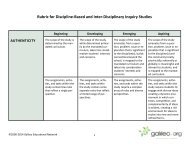Robot Utopia - Galileo Educational Network
Robot Utopia - Galileo Educational Network
Robot Utopia - Galileo Educational Network
You also want an ePaper? Increase the reach of your titles
YUMPU automatically turns print PDFs into web optimized ePapers that Google loves.
<strong>Robot</strong> <strong>Utopia</strong><br />
Human cities, especially newer ones are usually organized with orthogonal (right-angled) streets and<br />
avenues. Here is an example from Gaza:<br />
<strong>Robot</strong> cities are similar to human cities except they are perfect <strong>Utopia</strong>s... at least that's how the <strong>Robot</strong>s<br />
describe them. <strong>Robot</strong>s do not worry about aesthetics, but just want their cities to be as efficient as<br />
possible.<br />
In a <strong>Robot</strong> city, traveling one block takes a <strong>Robot</strong> exactly 1 second. Each intersection that a <strong>Robot</strong> moves<br />
through where the <strong>Robot</strong> has a choice of how to proceed also takes a second...<br />
For example the trip below from the top left (1,5) to the right side (6,3) is 9 blocks long and goes through 4<br />
intersections so it takes 13 seconds.<br />
<strong>Galileo</strong> <strong>Educational</strong> <strong>Network</strong><br />
www.galileo.org<br />
1
The trip from (2,2) to (5,6) is 7 blocks long and travels through 5 intersections so takes 12 seconds.<br />
<strong>Robot</strong>s are created in special <strong>Utopia</strong>n cities like CREAT-6x6. This city (like the ones pictured above) are 6 by<br />
6 as the name suggests. Each second a robot is created on a random intersection of CREAT-6x6 and then<br />
make their way to (1,1) to pick up their names, professions, and opinions.<br />
Design roads for CREAT-6x6 so that a robot never takes longer than 10 seconds to reach (1,1).<br />
<strong>Robot</strong>s spend most of their lives in <strong>Utopia</strong>n cities like GOOD-FOOD-6x6 delivering packets from one<br />
intersection to another.<br />
Design roads for GOOD-FOOD-6x6 so that a robot never takes longer than 11 seconds to go from one<br />
destination to another.<br />
Extensions:<br />
Design roads for CREAT-7x7 so that a robot never takes longer than 12 seconds to reach (1,1).<br />
Design roads for GOOD-FOOD-7x7 so that a robot never takes longer than 13 seconds to go from<br />
one destination to another.<br />
Is it always possible to design a road for CREAT-NxN that never takes more than 2N-2 seconds<br />
Is it always possible to design a road for GOOD-FOOD-NxN that never takes more than 2N-1<br />
seconds<br />
In HOSP-6x6 <strong>Robot</strong>s go to get fixed. Assume a <strong>Robot</strong> will always enter at (1,1), visit a random<br />
location,* and then leave at (6,6).<br />
o Find a <strong>Robot</strong> <strong>Utopia</strong>n design so that the robot never takes longer than 14 seconds.<br />
o Find a <strong>Robot</strong> <strong>Utopia</strong>n design so that the average time is not more than 13 seconds.<br />
o *The random locations include (1,1) and (6,6).<br />
<strong>Galileo</strong> <strong>Educational</strong> <strong>Network</strong><br />
www.galileo.org<br />
2
Not all <strong>Robot</strong> cities are squares. Like the name suggests, TRIANGLE-CREAT-9x9, is a triangularly<br />
shaped <strong>Robot</strong> <strong>Utopia</strong> where new robots are created. Is it possible to design a road system so that<br />
no matter which intersection a <strong>Robot</strong> is created on, it can always get to (1,1) in 10 seconds The<br />
road system below fails because there are two intersections on the lower road that takes longer<br />
than 10 seconds.<br />
<br />
Can you design a better road system Is it possible to design a road system for TRIANGLE-CREAT-<br />
8x8 so that no matter which intersection a <strong>Robot</strong> is created on, it can always get to (1,1) in 9<br />
seconds<br />
Game:<br />
<br />
<br />
<br />
<br />
Each player designs a <strong>Robot</strong> <strong>Utopia</strong> on a 6 by 6 grid.<br />
One person rolls a red and blue dice to determine the starting position of a robot. Everyone places<br />
a robot marker at this spot.<br />
Roll the red and blue dice to find the first destination.<br />
Keep a record of how long it takes for each person's robot to reach the destination in their <strong>Robot</strong><br />
<strong>Utopia</strong>. Roll the dice again to find your robot's next destination... do this 10 times. The person with<br />
the fastest total time is the winner.<br />
<strong>Galileo</strong> <strong>Educational</strong> <strong>Network</strong><br />
www.galileo.org<br />
3
Game Extension:<br />
<br />
Use two red and two blue dice and add them. Otherwise play the game the same as above on the<br />
following grid:<br />
The Math in This Problem:<br />
In this brainteaser, students will analyze and create various-sized grids. Since traveling from block to block<br />
takes one second and crossing an intersection takes an extra second, students are challenged to build<br />
efficient grids that only take a maximum of a specified number of seconds.<br />
<strong>Galileo</strong> <strong>Educational</strong> <strong>Network</strong><br />
www.galileo.org<br />
4








